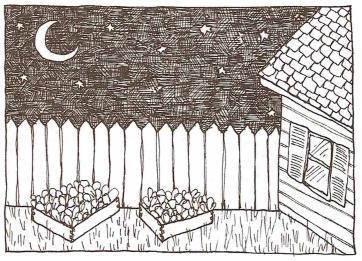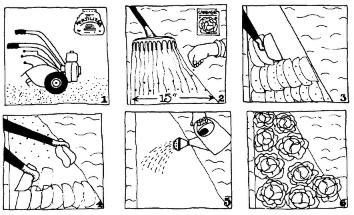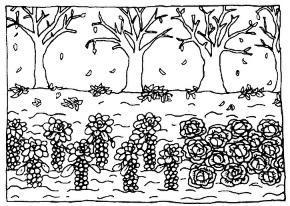Some people think that fall cole crops taste better than spring crops. Cole crops seem to do best if they're planted in warm weather and mature when the nights are cool and the days are crisp and sunny.
Why Plant in Fall?A fall cole crop garden is a bonus because it gives you fresh vegetables long after most of your crops have been harvested. Plant your cole crops (plus onions, greens, and root crops) twice; once in the spring and again in late summer for a fall harvest. In the fall, the ground may be cold and brown and covered with leaves, but you can still be cutting fresh broccoli and cabbage. You can harvest Brussels sprouts into January in the North -- they withstand hard frosts and a fair amount of snow.
A major benefit of a fall cole crop garden in the North is the lack of disease and insects. Pests hit hardest there in the spring and summer, and many harmful insects and bacteria are killed by the first cold snap. Southern and western gardeners, however, should be prepared to do battle with second and third generations of many insect pests.
You also don't have to bother with flats or peat pots indoors for your late crops; you can start the seeds right in the garden toward the end of summer.
For storage purposes, the fall garden has still another selling point. Late cabbage varieties are better keepers, so use the fall growing season to make the most of your garden space.

You can plant an entire fall feast of cole crops in about 15 minutes. In most parts of the country, wait until midsummer, then pick a garden spot that's produced an early crop, such as peas, carrots or onions, and prepare it for replanting.
Work the top 3 or 4 inches of soil and add 3- to 4-pounds of fertilizer to each 100 square feet of growing space. If you know your soil is very rich, add less fertilizer. Some fertilizer, especially if you used an organic one, from the previous crop is bound to be left in the soil. Work the fertilizer into the top few inches of soil.
Rake out a 15-inch-wide band for your row and sprinkle the seeds evenly down the row 4- to 8-inches apart. Don't worry about planting too thickly. You'll be taking some plants from the row in just a few weeks.
Firm the seeds into the soil with the back of a hoe. This contact with the soil ensures good germination. Cover the seeds with 1/2- to 3/4-inch of soil and firm again.

The air and soil temperatures are quite warm when you start these plants for the fall garden, so it's crucial to prevent the seeds and seedbed from drying out, or the seeds won't germinate. Keep the seedbed moist by sprinkling it every few days or by putting down a light layer of grass clippings or straw to serve as a mulch. This is one of the major keys to a successful fall garden.
When the plants are about 1 inch tall, thin them by removing enough seedlings so they stand 10- to 18-inches apart, depending on the variety. You can also wait another week or so and transplant all the seedlings to another garden spot. Or, thin the row carefully and transplant only the thinned seedlings. After that, just keep the rows weed free and watered, and you can look forward to a harvest that will last weeks after the first frost.
Some gardeners just lose interest after all the tomatoes and corn are harvested, but in the South, there's year-round growing potential for those who stick with it.
Cole crops are a natural in the South because once they're mature, they can stand some pretty low temperatures; 20° F won't hurt any cole crop but cauliflower. In the lower latitudes, don't be afraid to plant seedlings well into October. If you can work the soil, it's not too late to plant.
In some parts of the South you can harvest hardy crops while northern gardeners are totally snowbound. Who needs a root cellar or freezer with those possibilities?
Winter gardening is great in the South because the harmful insects that affect southern gardens are less of a problem, and the soil is apt to be moister.
You may do better by starting the fall cole crop seeds indoors, then transplanting them into the garden under shade cloth.
 Victory Seed Company has all the seeds you want for your best garden in 2024.
Victory Seed Company has all the seeds you want for your best garden in 2024.
For 25 years, the family-owned Victory Seed Company has provided the highest quality vegetable, herb and flower seeds to families across the country. We are passionate about providing you the best seeds available that give excellent germination, robust plants, and the harvest you want. With a catalog of over a thousand varieties, we have everything, and our prices are the kinds that we'd want to pay. We have hundreds of yesterday's heirloom vegetables, as well as today's award winning hybrid selections. Get to know us by visiting our website and browsing through our online vegetable seed catalog.
| 1. The Cole Crop Family |
| 2. Broccoli Essentials |
| 3. Cabbage Essentials |
| 4. Cole Crops and Soil |
| 5. Planning for Cole Crops |
| 6. Fall Cole Crop Bonus ← you're on this article right now |
| 7. Hardening-Off Your Cole Crops |
| 8. Starting Cole Crop Seeds Indoors |
| 9. Brussels Sprout Essentials |
| 1. The Cole Crop Family |
| 2. Broccoli Essentials |
| 3. Cabbage Essentials |
| 4. Cole Crops and Soil |
| 5. Planning for Cole Crops |
| 6. Fall Cole Crop Bonus ← you're on this article right now |
| 7. Hardening-Off Your Cole Crops |
| 8. Starting Cole Crop Seeds Indoors |
| 9. Brussels Sprout Essentials |